Business
Economic woes dominate as Bolivia prepares to go to the polls
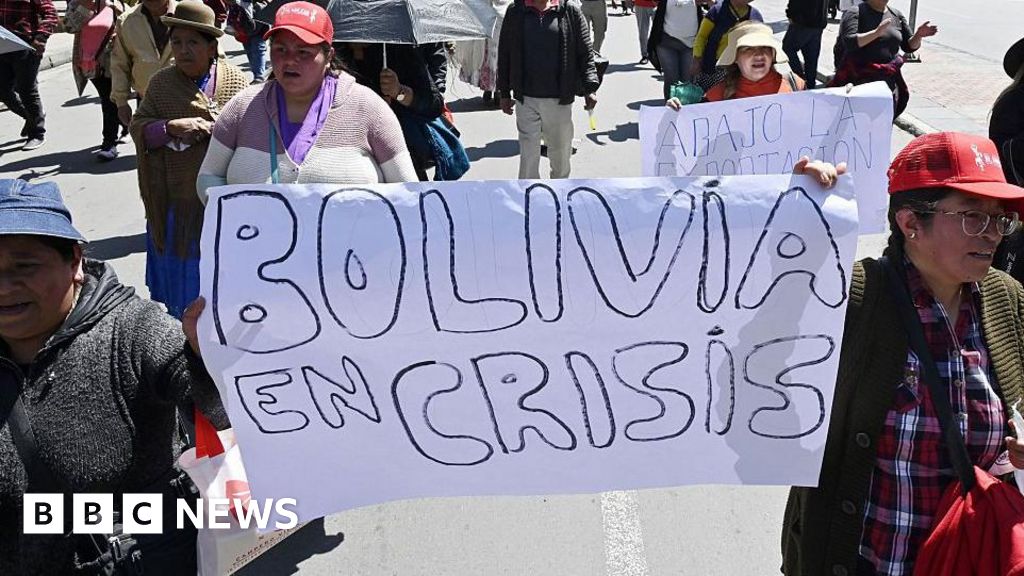
Business reporter
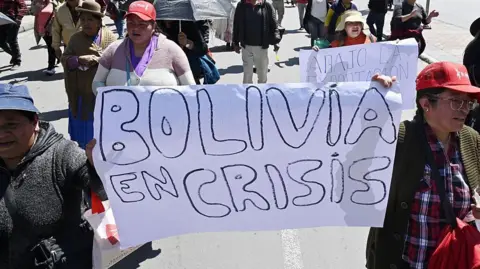 Getty Images
Getty ImagesAs Bolivians prepare to vote in a general election, the country’s deep economic woes are the central issue. Whoever becomes the nation’s next president faces a very difficult job to try to sort out the mess.
El Alto is Bolivia’s second-largest city, home to 1.2 million people. And, at an elevation of 4,150m (13,615ft), it is the world’s highest city with a population of more than 100,000.
It’s full of narrow streets with vendors trying to sell you everything from oranges to knock-off designer trainers. Standing on a pavement, car mechanic Josue Macias is enjoying an ice cream with his young son.
He describes how Bolivia’s sky-high inflation is affecting him and his family. The annual rate soared to 24% in June.
“Prices for everything are going up, but we are still earning the same,” he says. “We are just about getting by, but it’s hard because food prices are rising all the time, things like meat, oil and eggs. They are double or triple what they used to be.
“We’ve had to tighten our belts. We don’t go out to eat in restaurants anymore. Instead, I’m here on the street having an ice-cream with my son!”
Bolivia’s inflation spike has been caused by a combination of factors. Falling natural gas production and therefore exports of this key foreign earner has led to a decline in overseas revenues.
In turn, this has meant a shortage of US dollars, making it harder and more costly for the country to import petrol, diesel and food stuffs, leading to shortages and price hikes. It has led to street protests across the country.
At some petrol stations across the country, lorry drivers often have to wait more than 24 hours to fill up.
Taxi driver Gonzalo Ris is frustrated. As we drive along the pot-holed streets of La Paz, the country’s administrative capital, he tells me about his struggles.
“Before it was easy to fill up with petrol. Now I must wait for around four to six hours at the gas pump to get some, and that’s too much. It’s such a waste of time.
“And the prices are so expensive,” he adds. “Now the money we earn doesn’t cover our costs. But we can’t put our fares up because if we do, we won’t have any customers. It would be too expensive for them.”
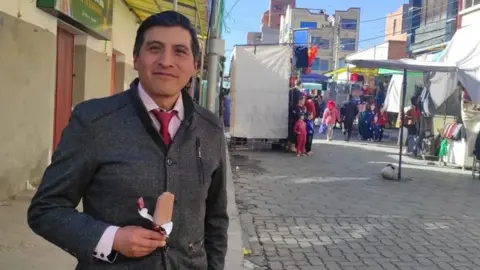
For almost 20 years the Bolivian government kept fuel prices artificially low through subsidies. This started when the government of then President Evo Morales nationalised the country’s hydrocarbon sector in 2006.
But in 2023, state energy company YPFB said Bolivia was running out of domestically-produced natural gas, due to a lack of investment in new exploration.
Without this gas to export, the Bolivian government is struggling to continue to find the funds to subsidise petrol and diesel. Last year it spent $2bn (£1.5bn) on such subsidies, according to a recent statement by a former minister of hydrocarbons and energy.
Outgoing left-wing President Luis Arce, who is not seeking re-election on 17 August, blamed the Bolivian parliament for the fall in natural gas production, accusing MPs of blocking vital oversea loans. His opponents in turn blame him for the economic turmoil.
The official exchange rate of Bolivia’s currency, the bolivianos, is certainly not helping matters. Since 2011 the government has fixed the exchange rate at 6.96 bolivianos to one US dollar.
But unofficially you can get 14 to 15 bolivianos per dollar. This has led to a thriving black market, especially of exports, from which the government misses out on tax revenue.
Economist Gary Rodriguez, the general manager for the Bolivian Institute of Foreign Trade, explains: “A product that costs seven bolivianos here in Bolivia can be sold for 15 bolivianos abroad,” he says.
“The problem is that businesses would prefer to sell items on the [overseas] black market rather than here in Bolivia which leads to food and fuel shortages.”
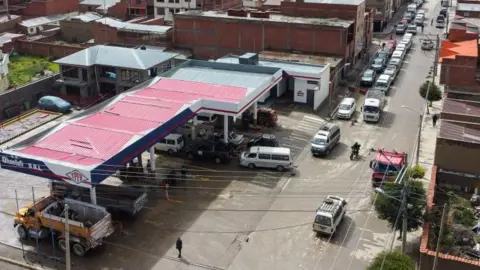 Getty Images
Getty ImagesRestrictions on the use of credit cards is another headache for Bolivia’s business community.
“The problem with the credit cards is that all the banks have limits that are ridiculous,” says Alessandra Guglielmi, who owns a food business called The Clean Spot.
“You can [only] spend around $35 a month over the internet with online purchases. $35 is nothing for a business.”
She is concerned about her business going under.
“I am worried with food prices going up I can’t afford to pay my staff a decent salary,” says Ms Guglielmi. “I am worried about the people not being able to afford to buy my products because I must put the prices up.
“And I am worried because my margins have gone down so it’s very hard right now for me to keep a business.”
Many people in Bolivia are hoping that a new government will be able to turn the country’s fortunes around. Two right-wing candidates are currently ahead in the polls for the presidential race.
Leading is Samuel Doria Medina of National Unity Front. He was previously the main shareholder of Bolivia’s largest cement manufacturer.
In second place is Jorge Quiroga of Freedom and Democracy. He has been president of Bolivia before, from 2001 to 2002.
If no candidate gets more than half the votes on 17 August – which no-one is expected to achieve – then there will be a second round of voting on 19 October.
Bolivian political scientist and analyst Franklin Pareja is sceptical that the next administration will be able to improve most people’s lives.

“The population is assigning a change in government almost magical qualities, because they think that with a change of government we’ll return to stability and prosperity,” he says. “And that’s not going to happen.
“Bolivia will only feel the hard impact of the economic crisis with a new government, because it will make structural economic changes, which will be unpopular.”
Mr Rodríguez is adamant that the Bolivian economy needs to be significantly altered. “We need to change the model, because the current model, has too much emphasis on the state,” he says.
“There are two actors, one the state sector and the other the private sector. The driver of development must be the citizen, the entrepreneur, and for that, the state must do what it’s meant to do. In other words, good laws, good regulations, good institutions.”
While polls suggest Bolivia’s next administration is likely to be right-wing, such radical governmental and economic change, to significantly reduce the state’s role, is not expected.
Business
South Korea: Online retail giant Coupang hit by massive data leak
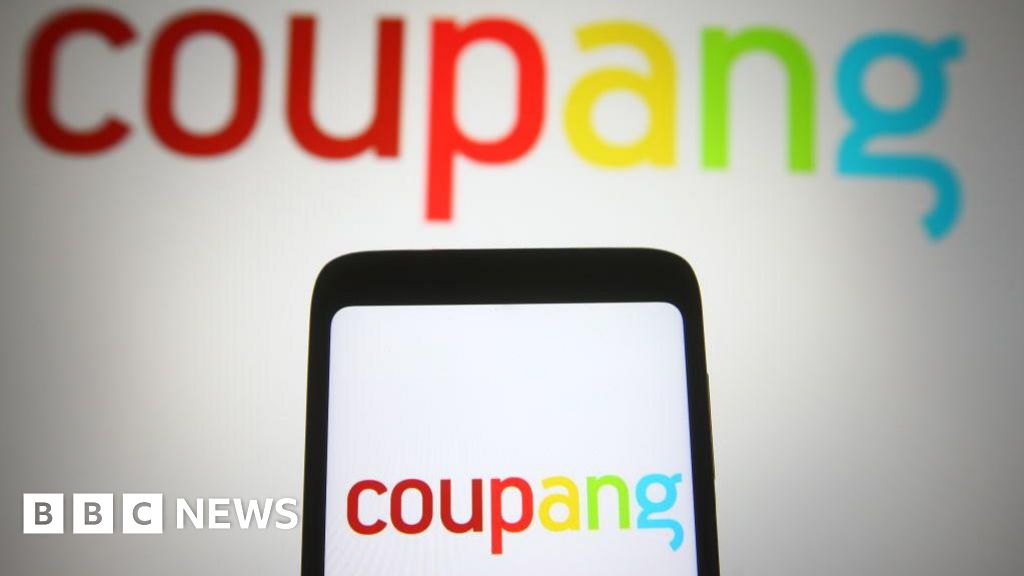
Osmond ChiaBusiness reporter
 Getty Images
Getty ImagesSouth Korea’s largest online retailer, Coupang, has apologised for a massive data breach potentially involving nearly 34 million local customer accounts.
The country’s internet authority said that it is investigating the breach and that details from the millions of accounts have likely been exposed.
Coupang is often described as South Korea’s equivalent of Amazon.com. The breach marks the latest in a series of data leaks at major firms in the country, including its telecommunications giant, SK Telecom.
Coupang told the BBC it became aware of the unauthorised access of personal data of about 4,500 customer accounts on 18 November and immediately reported it to the authorities.
But later checks found that some 33.7 million customer accounts – all in South Korea – were likely exposed, said Coupang, adding that the breach is believed to have begun as early as June through a server based overseas.
The exposed data is limited to name, email address, phone number, shipping address and some order histories, Coupang said.
No credit card information or login credentials were leaked. Those details remain securely protected and no action is required from Coupang users at this point, the firm added.
The number of accounts affected by the incident represents more than half of South Korea’s roughly-52 million population.
Coupang, which is founded in South Korea and headquartered in the US, said recently that it had nearly 25 million active users.
Coupang apologised to its customers and warned them to stay alert to scams impersonating the company.
The firm did not give details on who is behind the breach.
South Korean media outlets reported on Sunday that a former Coupang employee from China was suspected of being behind the breach.
The authorities are assessing the scale of the breach as well as whether Coupang had broken any data protection safety rules, South Korea’s Ministry of Science and ICT said in a statement.
“As the breach involves the contact details and addresses of a large number of citizens, the Commission plans to conduct a swift investigation and impose strict sanctions if it finds a violation of the duty to implement safety measures under the Protection Act.”
The incident marks the latest in a series of breaches affecting major South Korean companies this year, despite the country’s reputation for stringent data privacy rules.
SK Telecom, South Korea’s largest mobile operator, was fined nearly $100m (£76m) over a data breach involving more than 20 million subscribers.
In September, Lotte Cards also said the data of nearly three million customers was leaked after a cyber-attack on the credit card firm.
Business
Pakistan’s crisis differs from world | The Express Tribune
1729471601-0/image-(8)1729471601-0-640x480.webp)
Multiple elite clusters capture system as each extracts benefits in different ways
Pakistan’s ruling elite reinforces a blind nationalism, promoting the belief that the country does not need to learn from developed or emerging economies, as this serves their interests. PHOTO: FILE
KARACHI:
Elite capture is hardly a unique Pakistani phenomenon. Across developing economies – from Latin America to Sub-Saharan Africa and parts of South Asia – political and economic systems are often influenced, shaped, or quietly commandeered by narrow interest groups.
However, the latest IMF analysis of Pakistan’s political economy highlights a deeper, more entrenched strain of elite capture; one that is broader in composition, more durable in structure, and more corrosive in its fiscal consequences than what is commonly observed elsewhere. This difference matters because it shapes why repeated reform cycles have failed, why tax bases remain narrow, and why the state repeatedly slips back into crisis despite bailouts, stabilisation efforts, and policy resets.
Globally, elite capture typically operates through predictable channels: regulatory manipulation, favourable credit allocation, public-sector appointments, or preferential access to state contracts. In most emerging economies, these practices tend to be dominated by one or two elite blocs; often oligarchic business families or entrenched political networks.
In contrast, Pakistan’s system is not captured by a single group but by multiple competing elite clusters – military, political dynasties, large landholders, protected industrial lobbies, and urban commercial networks; each extracting benefits in different forms. Instead of acting as a unified oligarchic class, these groups engage in a form of competitive extraction, amplifying inefficiencies and leaving the state structurally weak.
The IMF’s identification of this fragmentation is crucial. Unlike countries where the dominant elite at least maintains a degree of policy coherence, such as Vietnam’s party-led model or Turkiye’s centralised political-business nexus, Pakistan’s fragmentation results in incoherent, stop-start economic governance, with every reform initiative caught in the crossfire of competing privileges.
For example, tax exemptions continue to favour both agricultural landholders and protected sectors despite broad consensus on the inefficiencies they generate. Meanwhile, state-owned enterprises continue to drain the budget due to overlapping political and bureaucratic interests that resist restructuring. These dynamics create a fiscal environment where adjustment becomes politically costly and therefore systematically delayed.
Another distinguishing characteristic is the fiscal footprint of elite capture in Pakistan. While elite influence is global, its measurable impact on Pakistan’s budget is unusually pronounced. Regressive tax structures, preferential energy tariffs, subsidised credit lines for favoured industries, and the persistent shielding of large informal commercial segments combine to erode the state’s revenue base.
The result is dependency on external financing and an inability to build buffers. Where other developing economies have expanded domestic taxation after crises, like Indonesia after the Asian financial crisis, Pakistan’s tax-to-GDP ratio has stagnated or deteriorated, repeatedly offset by politically negotiated exemptions.
Moreover, unlike countries where elite capture operates primarily through economic levers, Pakistan’s structure is intensely politico-establishment in design. This tri-layer configuration creates an institutional rigidity that is difficult to unwind. The civil-military imbalance limits parliamentary oversight of fiscal decisions, political fragmentation obstructs legislative reform, and bureaucratic inertia prevents implementation, even when policies are designed effectively.
In many ways, Pakistan’s challenge is not just elite capture; it is elite entanglement, where power is diffused, yet collectively resistant to change. Given these distinctions, the solutions cannot simply mimic generic reform templates applied in other developing economies. Pakistan requires a sequenced, politically aware reform agenda that aligns incentives rather than assuming an unrealistic national consensus.
First, broadening the tax base must be anchored in institutional credibility rather than coercion. The state has historically attempted forced compliance but has not invested in digitalisation, transparent tax administration, and trusted grievance mechanisms. Countries like Rwanda and Georgia demonstrate that tax reforms succeed only when the system is depersonalised and automated. Pakistan’s current reforms must similarly prioritise structural modernisation over episodic revenue drives.
Second, rationalising subsidies and preferential tariffs requires a political bargain that recognises the diversity of elite interests. Phasing out energy subsidies for specific sectors should be accompanied by productivity-linked support, time-bound transition windows, and export-competitiveness incentives. This shifts the debate from entitlement to performance, making reform politically feasible.
Third, Pakistan must reduce its SOE burden through a dual-track programme: commercial restructuring where feasible and privatisation or liquidation where not. Many countries, including Brazil and Malaysia, have stabilised finances by ring-fencing SOE losses. Pakistan needs a professional, autonomous holding company structure like Singapore’s Temasek to depoliticise SOE governance.
Fourth, politico-establishment reform is essential but must be approached through institutional incentives rather than confrontation. The creation of unified economic decision-making forums with transparent minutes, parliamentary reporting, and performance audits can gradually rebalance power. The goal is not confrontation, but alignment of national economic priorities with institutional roles.
Finally, political stability is the foundational prerequisite. Long-term reform cannot coexist with cyclical political resets. Countries that broke elite capture, such as South Korea in the 1960s or Indonesia in the 2000s, did so through sustained, multi-year policy continuity.
What differentiates Pakistan is not the existence of elite capture but its multi-polar, deeply institutionalised, fiscally destructive form. Yet this does not make reform impossible. It simply means the solutions must reflect the structural specificity of Pakistan’s governance. Undoing entrenched capture requires neither revolutionary rhetoric nor unrealistic expectations but a deliberate recalibration of incentives, institutions, and political alignments. Only through such a pragmatic approach can Pakistan shift from chronic crisis management to genuine economic renewal.
The writer is a financial market enthusiast and is associated with Pakistan’s stocks, commodities and emerging technology
Business
India’s $5 Trillion Economy Push Explained: Why Modi Govt Wants To Merge 12 Banks Into 4 Mega ‘World-Class’ Lending Giants
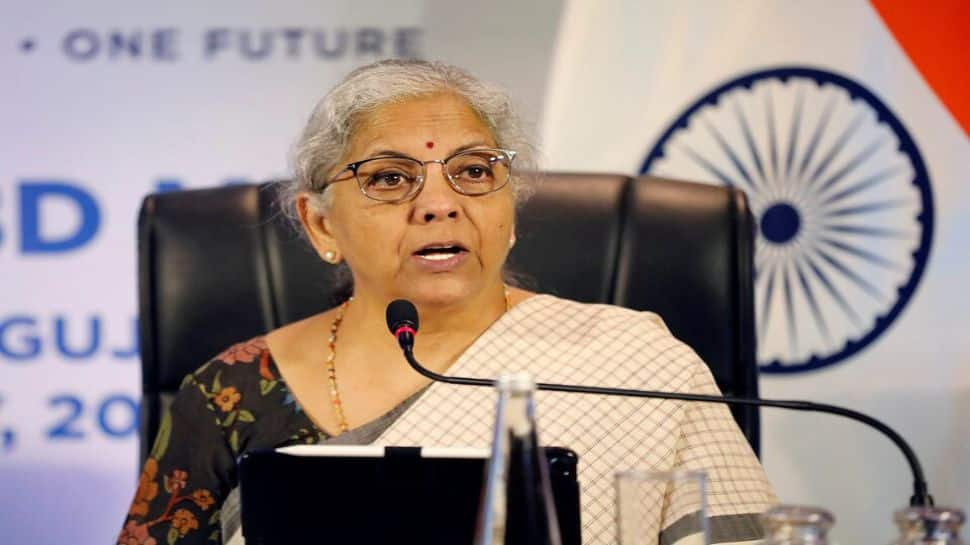
India’s Public Sector Banks Merger: The Centre is mulling over consolidating public-sector banks, and officials involved in the process say the long-term plan could eventually bring down the number of state-owned lenders from 12 to possibly just 4. The goal is to build a banking system that is large enough in scale, has deeper capital strength and is prepared to meet the credit needs of a fast-growing economy.
The minister explained that bigger banks are better equipped to support large-scale lending and long-term projects. “The country’s economy is moving rapidly toward the $5 trillion mark. The government is active in building bigger banks that can meet rising requirements,” she said.
Why India Wants Larger Banks
Sitharaman recently confirmed that the government and the Reserve Bank of India have already begun detailed conversations on another round of mergers. She said the focus is on creating “world-class” banks that can support India’s expanding industries, rising infrastructure investments and overall credit demand.
She clarified that this is not only about merging institutions. The government and RBI are working on strengthening the entire banking ecosystem so that banks grow naturally and operate in a stable environment.
According to her, the core aim is to build stronger, more efficient and globally competitive banks that can help sustain India’s growth momentum.
At present, the country has a total of 12 public sector banks: the State Bank of India (SBI), the Punjab National Bank (PNB), the Bank of Baroda, the Canara Bank, the Union Bank of India, the Bank of India, the Indian Bank, the Central Bank of India, the Indian Overseas Bank (IOB) and the UCO Bank.
What Happens To Employees After Merger?
Whenever bank mergers are discussed, employees become anxious. A merger does not only combine balance sheets; it also brings together different work cultures, internal systems and employee expectations.
In the 1990s and early 2000s, several mergers caused discomfort among staff, including dissatisfaction over new roles, delayed promotions and uncertainty about reporting structures. Some officers who were promoted before mergers found their seniority diluted afterward, which created further frustration.
The finance minister addressed the concerns, saying that the government and the RBI are working together on the merger plan. She stressed that earlier rounds of consolidation had been successful. She added that the country now needs large, global-quality banks “where every customer issue can be resolved”. The focus, she said, is firmly on building world-class institutions.
‘No Layoffs, No Branch Closures’
She made one point unambiguous: no employee will lose their job due to the upcoming merger phase. She said that mergers are part of a natural process of strengthening banks, and this will not affect job security.
She also assured that no branches will be closed and no bank will be shut down as part of the consolidation exercise.
India last carried out a major consolidation drive in 2019-20, reducing the number of public-sector banks from 21 to 12. That round improved the financial health of many lenders.
With the government preparing for the next phase, the goal is clear. India wants large and reliable banks that can support a rapidly growing economy and meet the needs of a country expanding faster than ever.
-

 Sports7 days ago
Sports7 days agoWATCH: Ronaldo scores spectacular bicycle kick
-

 Entertainment7 days ago
Entertainment7 days agoWelcome to Derry’ episode 5 delivers shocking twist
-

 Politics7 days ago
Politics7 days agoWashington and Kyiv Stress Any Peace Deal Must Fully Respect Ukraine’s Sovereignty
-

 Business1 week ago
Business1 week agoKey economic data and trends that will shape Rachel Reeves’ Budget
-

 Tech5 days ago
Tech5 days agoWake Up—the Best Black Friday Mattress Sales Are Here
-

 Fashion7 days ago
Fashion7 days agoCanada’s Lululemon unveils team Canada kit for Milano Cortina 2026
-

 Tech5 days ago
Tech5 days agoThe Alienware Aurora Gaming Desktop Punches Above Its Weight
-

 Politics1 week ago
Politics1 week ago53,000 Sikhs vote in Ottawa Khalistan Referendum amid Carney-Modi trade talks scrutiny





